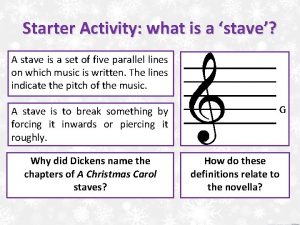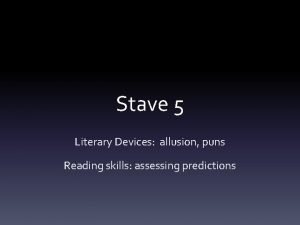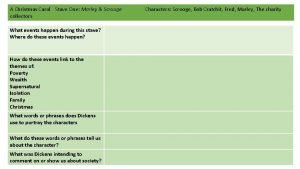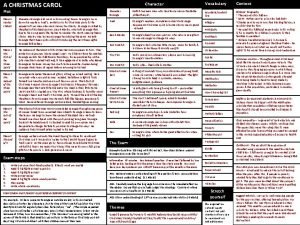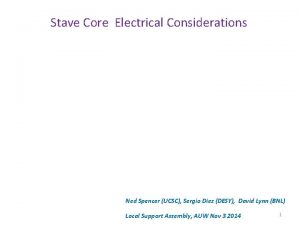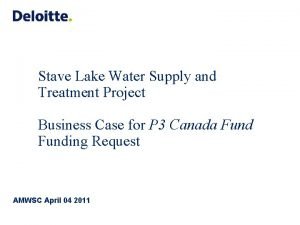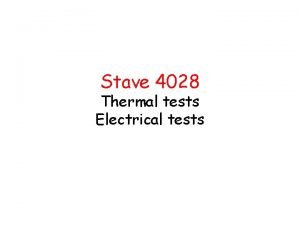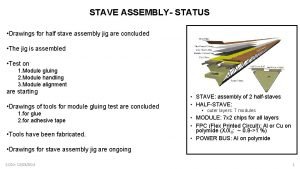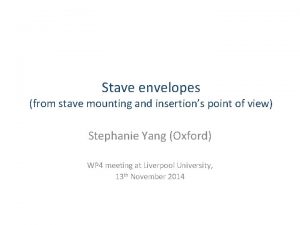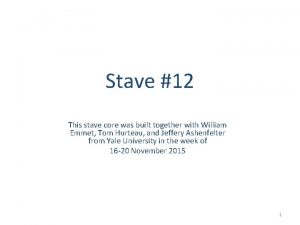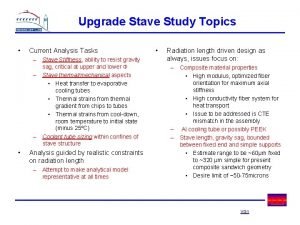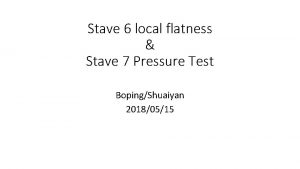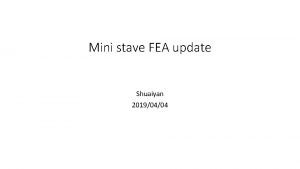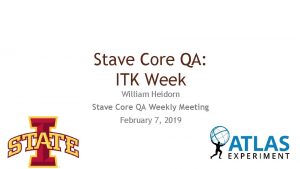Stave Module Status Tony Affolder The University of










- Slides: 10

Stave Module Status Tony Affolder The University of Liverpool On behalf of cast of thousands… ATLAS Upgrade Week November 10, 2010 1

Stave Module Requirements Design is driven by minimising material § Hybrid is substrate-less with no connectors § Glued directly on to the sensor § Use of minimal glue layers for both ASIC and hybrid attachment § Improves thermal paths and again reduces material § Layout optimised for stave and serial powering (parallel and DC-DC optional) § Control of M-shunt scheme serial powering built into hybrid with discrete components Optimized for mass production methods as well build will require >10000 circuits) (future § Yield and reliability of flex circuits taken into account from the beginning § Designed to enable mass wire bonding, component attachment and testing of circuits ATLAS Upgrade Week November 10, 2010 24

Hybrid Panels Versions § First version of hybrids had dot hatch at locations where jigs contacts surface § § § Results in up to ~40 mm tilts that are different for the 8 hybrid locations in panel As such, we used these panels to learn how thin a glue layer could be made and if it would be possible in large scale productions Provided modules to allow for development/studies of BCCs, PPB, HSIO developments, SP and DC/DC Landing Pads Laser cut § New version of hybrid have landing pads which are flat and planar w. r. t. ASIC sites to ~10 µm RMS § § Tabs § Already shown to make ASIC attachment much easier w/o glue wicking Ordered 15 panels (120 hybrids) and have obtained glass sensor dummies so we can do a proper glue study to set pattern and “final” thicknesses First gluing using new hybrids, hybrid flat at ~10 mm RMS Upgrade Project Office September 30, 2010 3

Stave Module – Noise Signature § In testing, we see systematic column-to-column variation in the noise caused by increased load capacitance to the ABCN-25 front-end due to the close proximity of hybrid ground/shield (65 mm nom. ) and within a column due to the tilts induced by dot hatch. § Noise is fairly consistent with simple model treating the additional capacitance in the same manner as the sensor backplane capacitance § Underestimates at large separations Nominal Thickness § I believe (I might be incorrect) the minimal increase to the load capacitance would be equal to that coming just from glue. § Changes the interstrip capacitance in the ratio of sum of dielectric constants of (glue+silicon) and (air+silicon) § Increases interstrip capacitance by 0. 2 p. F/cm coverage For 40µm glue layer, expect ~610 e on inner strips and ~630 e for outer strips § With current hybrids which overlap by 1. 5 cm and 0. 9 cm for outer and inner columns, this results in a noise increase of 25 and 15 e- respectively with ABCNext noise slope (80 e-/p. F) ATLAS Upgrade Week November 10, 2010 4

Hybrid-to-Sensor Glue Thicknesses § Due to new knowledge gained from first hybrid panels on the uniformity of hybrid thickness/flatness, noise performance and thin glue layers, I suggest that new nominal hybrid-to-sensor glue thickness to be set to 100 mm § Makes module assembly and noise much less sensitive to variations in glue and hybrid thicknesses § Would results noise of ~600 -610 e- with current shielded hybrids § Potential issues § Increased ASIC temperature - thermal models prediction increase of ASIC temperature of 1 C° changing thicknesses from 40 mm and 100 mm (100 mm is already default in all previous thermal models shown) § Increased mass - With current module build would increase module mass by 0. 3 g (2%) and radiation length module relatively by 1%. § I strongly believe advantages to producability and component yield far outweigh these potential issues and unless there is strong disagreement with this I will set jigging for 100 mm. ATLAS Upgrade Week November 10, 2010 5

Production Status • With old hybrid panels without landing pads • 12 modules made so far, all tested with BCC frames • 7 at RAL (4 mounted on stavelet) • 2 at CERN cooling down after irradiation • 3 at Liverpool, 1 for DC/DC load, 2 used “failed” sensors for new wire bonder (BJ 820) commissioning (1 with epoxy under ASICS) • With new hybrid panels with landing pads • 8 new hybrids bonded and fully functional • New landing pads work with very good uniformity of silver epoxy • 3 modules assembled • Shieldless/shielded module tested with BCC • Other two await wire bonding ATLAS Upgrade Week November 10, 2010 6

Module Production Tooling Status § 2 sets of hybrid/module production tooling will be completed by end of the week § Cambridge is visiting Monday-Tuesday next week to training on how to use them which will generate use documentation § Second set will be sent to West Coast (LBL/UCSC) with this instruction set § Jig Status § The hybrid jigs for ASIC attachment, bonding and testing are “final” and shouldn’t have to change near term § The module assembly jig will need updates, for example after gluing studies to set “final” glue thicknesses. For now, shims have to be used to set heights § Relatively easy to send out to users § The module bonding and testing jigs are also “final” § We may be able to make additional sets of hybrid jigs in the near term to get other sites started in a few months Upgrade Week November 10, Feb 2010 ATLAS Tracker Upgrade Week, 23 rd-27 th 09 7

Further Material Reduction • With current stave module and ABCN 25, discretionary material dominated by copper and ASIC • • To learn as much as we can with current ASIC set, we will first focus on removing copper and then discretes • • Both already will be reduced with new ASIC set, i. e. half the ASICs and roughly half the hybrid area Kapton 5% Solder Resist 1% Silver Epoxy 2% Hybrid Glue 1% Discretes 8% ASICs 11% Silicon 43% More an advantage for hybrid stuffing in production than mass Biggest copper removal would be current thick shield (~20 mm or ~30% of copper weight) • See next slide on shieldless module • Next reduction would be reducing copper content in power layer Copper 29% ATLAS Upgrade Week November 10, 2010 Current Module w/shield 8

Shieldless Module § Assembled module with one shielded and one shieldless hybrid Outer Column- 615 e- § Used 40 mm glue thickness. § Shieldless hybrid ground plane 75 mm from back of hybrid (50 mm pre-preg+25 mm solder resist) § Roughly equivalent to 100 mm glue with shielded hybrid for load capacitance § Tested in SP chain using SCTDAQ and BCC with shieldless module AC-coupled § No high noise channels seen in 3 pt gain measurement § Will follow up with 2 trigger test once made available (HSIO) Inner Column- 601 e- 1 f. C 3 point gain, untrimmed No reduction in electrical performance yet for going to shieldless hybrid. Reduce copper by ~30% and hybrid circuit production costs by ~30%. Upgrade Week November 10, Feb 2010 ATLAS Tracker Upgrade Week, 23 rd-27 th 09 9

Near term Plans § Distribute production tools to 2 site groupings § QA on new shipment of 120 hybrids ~Nov. 15 th § Take time to do proper glue study to optimize hybrid-to-sensor glue uniformity and coverage § Using glass sensors dummies and new shipment of hybrids § Consolidate metrology programmes (both data taking and analysis) § Make another small submission of hybrid panels to test more ideas to improve flatness of hybrid after re-flow and to further reduce mass (removing copper for power and ground planes) § Make a frame compatible with the DC/DC stave package for single module test § Start testing of the 2 irradiated modules at CERN Upgrade Week November 10, Feb 2010 ATLAS Tracker Upgrade Week, 23 rd-27 th 09 10
 What is a stave
What is a stave Stave 5 a christmas carol
Stave 5 a christmas carol Scrooge allusion
Scrooge allusion Christmas carol stave 1 summary
Christmas carol stave 1 summary A christmas carol stave 1 summary bullet points
A christmas carol stave 1 summary bullet points How is marley's ghost presented in stave 1
How is marley's ghost presented in stave 1 Oh tell me i may sponge away the writing on this stone
Oh tell me i may sponge away the writing on this stone Christmas carol stave 4 summary
Christmas carol stave 4 summary Electrical stave
Electrical stave Stave lake water level
Stave lake water level Electrical stave
Electrical stave
